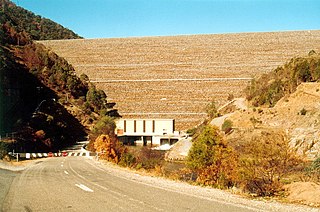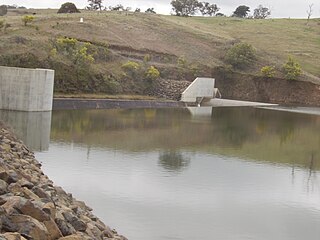South Para Reservoir is the second largest reservoir in South Australia, behind Mount Bold Reservoir, and the principal reservoir of the South Para River system. The reservoir's large capacity of around 45,330 megalitres and its location in the catchment area mean that it only ever fills completely once in every five years.

A reservoir is a storage space for fluids. These fluids may be water, hydrocarbons or gas. A reservoir usually means an enlarged natural or artificial lake, storage pond or impoundment created using a dam or lock to store water. Reservoirs can be created by controlling a stream that drains an existing body of water. They can also be constructed in river valleys using a dam. Alternately, a reservoir can be built by excavating flat ground or constructing retaining walls and levees. Tank reservoirs store liquids or gases in storage tanks that may be elevated, at grade level, or buried. Tank reservoirs for water are also called cisterns.

South Australia is a state in the southern central part of Australia. It covers some of the most arid parts of the country. With a total land area of 983,482 square kilometres (379,725 sq mi), it is the fourth-largest of Australia's states and territories by area, and fifth largest by population. It has a total of 1.7 million people, and its population is the second most highly centralised in Australia, after Western Australia, with more than 77 percent of South Australians living in the capital, Adelaide, or its environs. Other population centres in the state are relatively small; Mount Gambier, the second largest centre, has a population of less than 30,000.

Mount Bold Reservoir is the largest reservoir in South Australia with a maximum capacity of over forty-six thousand megalitres. Costing A$1.1 million, the reservoir took six years to construct on the Onkaparinga River system between 1932 and 1938. The reservoir does not connect directly to the main reticulation system; rather, to maintain levels at Clarendon Weir, water is released only as required. Much of the water from Mount Bold will eventually end up at Happy Valley Reservoir and used to supply parts of the Mount Lofty Ranges and also Adelaide.
Costing A$6.4 million, the reservoir took almost a decade to construct, between 1949 and 1958, due to a demand on resources in the post-war boom. The building of the historic Mannum-Adelaide Pipeline from the River Murray to the water-short city of Adelaide was a key delay in South Para's construction; that Pipeline today disperses water into the reservoir.

The Australian dollar is the currency of Australia, and of three independent Pacific Island states, specifically Kiribati, Nauru, and Tuvalu. It was introduced on 14 February 1966 when the pre-decimal Australian pound, with its system of shillings and pence, was replaced by the new decimal currency, the Australian dollar.

The Murray River is Australia's longest river, at 2,508 kilometres (1,558 mi) in length. The Murray rises in the Australian Alps, draining the western side of Australia's highest mountains, and then meanders across Australia's inland plains, forming the border between the states of New South Wales and Victoria as it flows to the northwest into South Australia. It turns south at Morgan for its final 315 kilometres (196 mi), reaching the ocean at Lake Alexandrina.

Adelaide is the capital city of the state of South Australia, and the fifth-most populous city of Australia. In June 2017, Adelaide had an estimated resident population of 1,333,927. Adelaide is home to more than 75 percent of the South Australian population, making it the most centralised population of any state in Australia.
The Reservoir is surrounded by nature reserve and has been a focus for two major revegetation projects, the first in the late 1950s when over 5000 trees and shrubs were planted, and the second as part of the South Australian Government's "Million Trees" initiative.

The Government of South Australia, also referred to as the South Australian Government, is the Australian state democratic administrative authority of South Australia. The Government of South Australia, a parliamentary constitutional monarchy, was formed in 1856 as prescribed in its Constitution, as amended from time to time. Since the Federation of Australia in 1901, South Australia has been a state of the Commonwealth of Australia, and the Constitution of Australia regulates its relationship with the Commonwealth. Under the Australian Constitution, South Australia ceded legislative and judicial supremacy to the Commonwealth, but retained powers in all matters not in conflict with the Commonwealth.
In 1979 the mutilated body of 17-year-old Alan Barnes was found after being dumped in the South Para Reservoir. His murder, one of the five cases known as The Family Murders remains unsolved.
The Family was the name given to a close-knit group of men believed to be involved in the kidnapping, sexual abuse and, at times, torture of young men and teenage boys in and around Adelaide, South Australia, from the 1970s to the mid-1980s.
- Capacity: 45,330 ML
- Length of wall: 284 m
- Height of wall: 44.2 m
- Type of wall: rolled fill

Dartmouth Dam is a large rock-fill embankment dam with an uncontrolled chute spillway across the Mitta Mitta, Gibbo, and Dart rivers, the Morass Creek and a number of small tributaries. The dam is located near Mount Bogong in the north-east of the Australian state of Victoria. The dam's purpose includes irrigation, the generation of hydro-electric power, water supply and conservation. The impounded reservoir is called Dartmouth Reservoir, sometimes called Lake Dartmouth. The Dartmouth Power Station, a hydro-electric power station that generates power to the national grid, is located near the dam wall.

Warragamba Dam, a concrete gravity dam, creates Lake Burragorang, the primary reservoir for water supply for the Australian city of Sydney, New South Wales.

Glenbawn Dam is a major ungated earth and rock fill with clay core embankment dam with concrete chute spillway plus fuse plugs across the Hunter River upstream of Aberdeen in the Hunter region of New South Wales, Australia. The dam's purpose includes flood mitigation, hydro-electric power, irrigation, water supply and conservation. The impounded reservoir is called Lake Glenbawn.

The River Torrens is the most significant river of the Adelaide Plains and was one of the reasons for the siting of the city of Adelaide, capital of South Australia. It flows 85 kilometres (53 mi) from its source in the Adelaide Hills near Mount Pleasant, across the Adelaide Plains, past the city centre and empties into Gulf St Vincent between Henley Beach South and West Beach. The upper stretches of the river and the reservoirs in its watershed supply a significant part of the city's water supply. The river's long linear parks and a constructed lake in the lower stretch are iconic of the city.

The Happy Valley Reservoir is a water reservoir located in Adelaide, Australia. Constructed when the total population of Adelaide numbered 315,200, the Happy Valley Reservoir now supplies over a half a million people, from Adelaide's southern extent to the city-centre. It is also home to lots of wildlife including many kangaroos.

Barossa Reservoir is a reservoir in the Australian state of South Australia, built between 1899 and 1902 to supply water to Gawler and other northern country areas. Built at a cost of almost £170,000 the reservoir was hailed on completion as an engineering marvel, and at a total of 36 metres, was the highest in Australia. The thin arch of the dam retaining wall, curved against the pressure of the water, was an innovation considered radical, and attracted the Reservoir international attention. It was featured in the Scientific American and caused the American Engineers News to remark that its "boldness of design deserves to rank with the most famous dams in the world". Nowadays, the dam is notable for its parabola effect, where a voice can be heard clearly from one side to the other — over 140 metres, end to end. This unusual acoustic phenomenon is a popular tourist attraction, and has earned the dam the title "Whispering Wall".

The Blowering Dam is a major ungated rock fill with clay core embankment dam with concrete chute spillway across the Tumut River upstream of Tumut in the Snowy Mountains region of New South Wales, Australia. The dam's purpose includes flood mitigation, hydro-power, irrigation, water supply and conservation. The dam is part of the Snowy Mountains Scheme, a vast hydroelectricity and irrigation complex constructed in south-east Australia between 1949 and 1974 and now run by Snowy Hydro. The impounded reservoir is called Blowering Reservoir.

The Wivenhoe Dam is a rock and earth-fill embankment dam with a concrete spillway across the Brisbane River in South East Queensland, Australia. The dam wall is located about 80 kilometres (50 mi) by road from the centre of Brisbane. The primary purpose of the dam is the supply of potable water for the Brisbane and Ipswich regions. In addition, the dam also provides for flood mitigation control, hydroelectricity and for recreation. The impounded reservoir is called Lake Wivenhoe and the dam, the lake and a narrow strip of surrounding land forms a locality also called Lake Wivenhoe.

Googong Dam is a minor ungated earth and rock fill with clay core embankment dam with concrete chute spillway plus a nearby 13 metres (43 ft) high earthfill saddle embankment across the Queanbeyan River upstream of Queanbeyan in the Capital Country region of New South Wales, Australia. The dam's purpose includes water supply for Canberra and Queanbeyan. The impounded reservoir is called Googong Reservoir.

The Ross River Dam is a rock and earthfill-filled embankment dam across the Ross River, located between Kelso and Mount Stuart in the City of Townsville in northern Queensland, Australia. Built initially for flood control, Lake Ross, the impoundment created by the dam, serves as one of the major potable water supplies for the region.

Gosling Creek Dam is a decommissioned minor earth and rock fill with clay core embankment dam with concrete chute spillway across the Gosling Creek upstream of Orange in the central western region of New South Wales, Australia. Commissioned in 1890 to supply Orange with potable water, the dam was decommissioned after the official commissioning of the Suma Park Dam in 1962. The impounded reservoir is called Gosling Creek Reservoir and is now used for recreation purposes.

Cardinia Reservoir is an Australian man-made water supply dammed reservoir. The 287,000-megalitre (6.3×1010 imp gal; 7.6×1010 US gal) water store is located in Emerald-Clematis-Dewhurst in south-eastern suburbs of Melbourne, Victoria. Construction started in May 1970 and was completed in 1973 at a cost of more than A$11.4 million. The dam that creates the impoundment is called the Cardinia Dam.

Split Rock Dam is a minor ungated concrete faced rock fill embankment dam with concrete chute spillway across the Manilla River upstream of Manilla in the north-western slopes region of New South Wales, Australia. The dam's purpose includes flood mitigation, irrigation, water supply and conservation. The impounded reservoir is called Split Rock Reservoir.

The Fairbairn Dam is an earthfill-filled embankment dam across the Nogoa River, located southwest of Emerald in Central Queensland, Australia. Constructed in 1972 for the primary purpose of irrigation, the impoundment created by the dam serves as one the major potable water supplies for the region and assists with some flood mitigation. Lake Maraboon with an active capacity of 1,301,000 ML (2.86×1011 imp gal; 3.44×1011 US gal) was formed by damming of the Nogoa River, and, in 2008, was Queensland's second largest dam. Maraboon is the Aboriginal for "where the black ducks fly".

The Wappa Dam is a mass concrete gravity arch dam with earth-fill abutments and an un-gated spillway across the South Maroochy River that is located in the South East region of Queensland, Australia. The main purpose of the dam is for supply of potable water for the Sunshine Coast region. The impounded reservoir is also called Wappa Dam.

The Ewen Maddock Dam is an earth-fill embankment dam with an un-gated spillway across the Addlington Creek that is located in the South East region of Queensland, Australia. The main purpose of the dam is for potable water supply of the Sunshine Coast region.
Kidston Dam as so known as Copperfield Dam and was a dam near Hughenden built for the local mine. The Kidston Gold Mine closed July 2001. It has a capacity of 20 400 ML.
As the country's supply of freshwater is increasingly vulnerable to droughts, possibly as a result of climate change, there is an emphasis on water conservation and various regions have imposed restrictions on the use of water.

Little Para Reservoir is a reservoir in South Australia serving the city of Adelaide. It was built between 1974 and 1977, costing A$11.5 million, and commissioned in January 1979.

Ben Chifley Dam, or Chifley Dam, is a rock and earth-fill embankment dam across the Campbells River in the central west region of New South Wales, Australia. The main purpose of the dam is to supply potable water to the city of Bathurst.





























